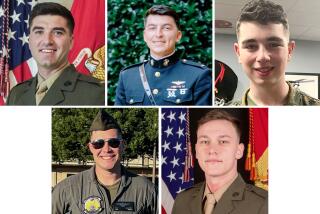COUNTYWIDE : Very Last Warriors Back Home
- Share via
The last 250 Marines from Orange County serving in Operation Desert Storm returned home Tuesday, saying that the hardest part of their ordeal was remaining in the Saudi desert after everyone else went home.
The 15 desert-brown, camouflaged helicopters carrying the 250 Marines left the USS New Orleans off the California coast and flew to Tustin Marine Corps Air Station. They were greeted by hundreds of family members holding brightly colored balloons, placards and banners while a Marine band played.
Wives, children and friends cheered wildly as the helicopters circled the base in formation and landed. As soon as the rotor blades stopped, the crowd broke through the yellow, crowd-control tape and rushed toward the helicopters.
“I couldn’t stop them,” one officer said. “There was no way. I just let them go.”
Known as the Red Dragons, the Tustin-based helicopter force left in early December from San Diego, remained on ships for weeks in the Persian Gulf as part of the famous amphibious “feint” force that held divisions of the Iraqi army at bay in Kuwait, and then flew ashore the day the ground war broke out to transport troops, supplies and the wounded.
Altogether, the squadron--composed of CH-46 Sea Knight and CH-53E Super Stallion helicopters--spent 270 days away from home, 204 of them aboard ship, commanding officer Lt. Col. Wayne Forbush said.
“I think the hardest part for us was being there after everyone else left,” Forbush commented. “We were at this base in Saudi Arabia and everyone had left except us, and they were literally taking the field up, and as we left . . . there was hardly enough room to park the helicopters.”
The Marines in the squadron used to joke that everybody, even the prisoners of war, were gone.
“Everyone was home except us. We had a saying--there was Desert Shield, Desert Storm and Desert Stay,” said Lt. Col. John LeMoine, executive officer of the Red Dragons.
“So it was very, very difficult emotionally, knowing that everything was over and yet we were still there,” said Forbush.
After spending weeks aboard ships poised to attack on a moment’s notice, the squadron, once the ground war began, flew thousands of Marines ashore to an area near the Kuwait-Saudi border.
From their new base at Tanajib, 40 miles south of Kuwait in the Saudi desert, the helicopters, accompanied by Cobra gunships, flew into Kuwait carrying thousands of pounds of supplies and hundreds of troops, returning with the wounded.
Although HMM-268 did not get the publicity that the Marine ground forces got when they smashed through the enemy’s border positions, the helicopter squadron, according to military officials, was an intricate part of the supply line that fed the stream of Marines that moved north, capturing and holding Kuwait city.
After the four-day ground war ended, HMM-268 began reloading Marine equipment onto ships in the Persian Gulf. During its tour, the squadron flew 2,281 hours, carrying 11,266 passengers and 2.8 million pounds of supplies.
Forbush said the squadron left the Gulf on July 15 and went to Singapore and to the Philippine Islands.
“It’s wonderful to be home,” said Maj. Bruce Banigan, commander of one of the giant Super Stallions called “Lady Luck.” “The trip back was good--good weather and no problem with the ships and everything went well.”
“We have been up cleaning all night,” said Michele Gray of Tustin, as she waited anxiously for her husband. “He’s never been gone before. Nine months is a long time.”
“It was good duty,” her husband, Sgt. Jeff Gray, said as he embraced her. “But I’m glad to be home.”
More to Read
Sign up for Essential California
The most important California stories and recommendations in your inbox every morning.
You may occasionally receive promotional content from the Los Angeles Times.













